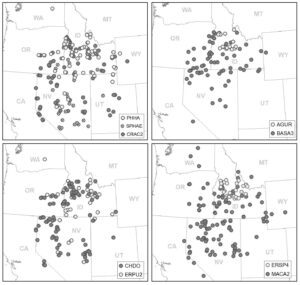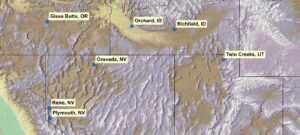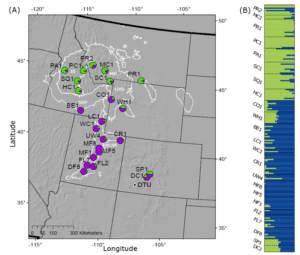Authors
Francis Kilkenny, Sarah Barga, Jessica Irwin, Kimberly Rizkowsky, Bryce Richardson, Kas Dumroese, USFS RMRS
Rob Massatti, Daniel Winkler, John Bradford, USGS
Beth Leger, Tessa Bartz, UNR
Andrew Kulmatiski, Julia Aaronson, USU
Owen Baughman, TNC
Overview
From 2017 to 2021 the RMRS Boise lab coordinated the collection of forb seed and tissue for research purposes from across the Columbia, Snake and Great Basins. The species collected include Agastache urticifolia, Balsamorhiza sagittata, Chaenactis douglasii, Crepis acuminata, Erigeron pumilus, Erigeron speciosus, Machaeranthera (Dieteria) canescens, Phacelia hastata, Sphaeralcea grossulariifolia, Sphaeralcea munroana, and Sphaeralcea parvifolia.
Table 1.Number of research seed collections by species and agency from 2017-2021. AGUR = Agastache urticifolia, BASA3 = Balsamorhiza sagittata, CHDO = Chaenactis douglasii, CRAC2 = Crepis acuminata, ERPU2 = Erigeron pumilus, ERSP4 = Erigeron speciosus, MACA = Machaeranthera (Dieteria) canescens, SPHAE = Sphaeralcea species, used collectively for S. munroana, S. grossulariifolia and S. parvifolia.
|
AGUR |
BASA3 |
CHDO |
CRAC2 |
ERPU2 |
ERSP4 |
MACA |
PHHA |
SPHAE |
Total |
|
|
RMRS |
17 |
42 |
60 |
36 |
34 |
29 |
73 |
54 |
13 |
358 |
|
BLM |
0 |
6 |
48 |
31 |
5 |
0 |
53 |
4 |
18 |
165 |
|
NFS |
0 |
5 |
2 |
11 |
1 |
0 |
5 |
20 |
1 |
45 |
|
FWS |
0 |
11 |
4 |
2 |
0 |
0 |
1 |
0 |
1 |
19 |
|
Total |
17 |
64 |
114 |
80 |
40 |
29 |
132 |
78 |
33 |
587 |

Figure 1. Distribution of research collections from 2017-2021, by species. AGUR = Agastache urticifolia, BASA3 = Balsamorhiza sagittata, CHDO = Chaenactis douglasii, CRAC2 = Crepis acuminata, ERPU2 = Erigeron pumilus, ERSP4 = Erigeron speciosus, MACA = Machaeranthera (Dieteria) canescens, SPHAE = Sphaeralcea species, used collectively for S. munroana, S. grossulariifolia and S. parvifolia.

Figure 2. Distribution of research collections from 2017-2021, by contributing agency. RMRS = US Forest Service, Rocky Mountain Research Station, BLM = Bureau of Land Management, NFS = US Forest Service, National Forest System, FWS = US Fish and Wildlife Service.
Species in the common garden array include: (installed 2019) Machaeranthera (Dieteria) canescens, Chaenactis douglasii, and Crepis intermedia, (installed 2020) Erigeron pumilus, (installed 2021) Phacelia hastata, (being installed 2022) Balsamorhiza sagittata. Experimental plants were grown at the RMRS Moscow greenhouses. Due to extenuating circumstances, the 2019 planting of Crepis acuminata was unsuccessful; we are partnering with Beth Leger (UNR) to attempt a second grow-out and installation in 2022. The priority species Erigeron specious was not included as part of the GBNPP forb common garden array, but a common garden study was performed through an internal USFS partnership between Region 1 and Region 4. Preliminary seed zones are available from that study.
Table 2. Plant species and populations grown for installation into the common gardens
|
Species |
Number of Populations |
|
Machaeranthera canescens |
112 |
|
Chaenactis douglasii |
89 |
|
Erigeron pumilus |
39 |
|
Phacelia hastata |
37 |
|
Balsamorhiza sagittata |
~69 |
|
Crepis acuminata |
~71 |
Common garden locations – As of fall 2021, we have installed 7 forb common gardens in 4 states across the Great Basin (Figure 1). We specifically selected sites that represent a gradient in environmental characteristics related to moisture and temperature.

Figure 3. Map of forb common garden locations that are included in this study as of 2021. Additional gardens may be installed for B. sagittata in 2022.
We have partnered with multiple organizations to help with monitoring the common gardens in different locations, including: The Nature Conservancy (Glass Butte, OR), Utah State University (Twin Creeks, UT), and University of Nevada, Reno (Plymouth and Reno, NV). The RMRS Boise lab and our academic project collaborators are also conducting complementary research to add value to the forb common garden study (Table 2).
Table 2. Complementary research conducted by RMRS and academic partners
|
Researcher |
Projects looking at population-level variation |
|
RMRS Boise Lab |
Seed dormancy and germination |
|
Utah State University – Logan, UT Julia Aaronson, Andrew Kulmatiski |
|
|
University of Nevada, Reno Tessa Bartz, Beth Leger |
|
We germination studies for both C. douglasii and M. canescens. Preliminary results indicate that:
-
C. douglasii: while seeds generally germinated in warm conditions after periods of cold, seeds from some populations germinated under cold conditions
-
M. canescens: while dormancy is generally low and seeds do not require cold stratification, seeds from some populations germinated under cold conditions
The ability to germinate under cold conditions may be beneficial for populations coming from areas with shorter growing seasons. So, even if it is easy to germinate the seeds in an agronomic setting (e.g. seed increase), there may be population-level variation in adaptations that allow for early germination, under winter conditions. This may be linked to seed source climate and may be important to consider when selecting a population for restoration.
Beginning in 2017 personnel at RMRS and USGS have collaborated on a study of genetic variation in the focal forb species. The populations in this study are selected to match the populations used in the common garden array and 10 individuals are sampled per population.
Table 3. Progress in genetic marker work for forb species from 2017-2021.
|
Species |
DNA Extraction |
Flow Cytometry |
Sequencing |
Analysis |
Journal Article |
|
Erigeron speciosus |
Completed |
Completed |
Completed |
Completed |
In Revision |
|
Machaeranthera canescens |
Completed |
Not Needed |
Completed |
Completed |
In Prep |
|
Chaenactis douglasii |
Completed |
Completed |
Completed |
In Progress |
Not Started |
|
Erigeron pumilus |
Completed |
In Progress |
Completed |
In Progress |
Not Started |
|
Crepis acuminata |
Completed |
In Progress |
In Progress |
Not Started |
Not Started |
|
Sphaeralcea spp. |
Completed |
In Progress |
In Progress |
Not Started |
Not Started |
|
Phacelia hastata |
In Progress |
In Progress |
Not Started |
Not Started |
Not Started |
|
Balsamorhiza sagittata |
In Progress |
In Progress |
Not Started |
Not Started |
Not Started |
- Preliminary results indicate that Erigeron speciosus has large northern and southern genetic clusters that are divided by the snake river plain; that Machaeranthera canescens is divided into five genetic clusters that generally correspond to level III ecoregions in the western United States; and, that Chaenactis douglasii has significant ploidy variation among populations.

Figure 4. Genetic structure of Erigeron speciosus populations. Colors depict distinct clusters. Pie charts with multiple colors indicate likely admixture between clusters.

Figure 5.Genetic structure of Machaeranthera canescens populations. Colors depict distinct clusters. Pie charts with multiple colors indicate likely admixture between clusters.
Overall, this project will result in the following products:
- Establishment of a common garden array
- General Technical Report: common garden design and installation
- Seed accessions representing many populations of native species used in arid land restoration
- Identification of ploidy and genetic clusters for focal native plant species
- Geospatial seed transfer guidance for use in online tools
- Several publications describing population-level variation in: seed germination, soil interactions, drought tolerance, and competition with invasive species
Purpose
This is a large-scale effort being carried out by the GBNPP with the goal of examining how flexible populations of native forb species are to being moved into novel locations. To test this, and large common garden array has been installed and is being monitored throughout the growing season.
Geography
As of fall 2021, we have installed seven forb common gardens in four states across the Great Basin (Figure 1). We specifically selected sites that represent a gradient in environmental characteristics related to moisture and temperature.